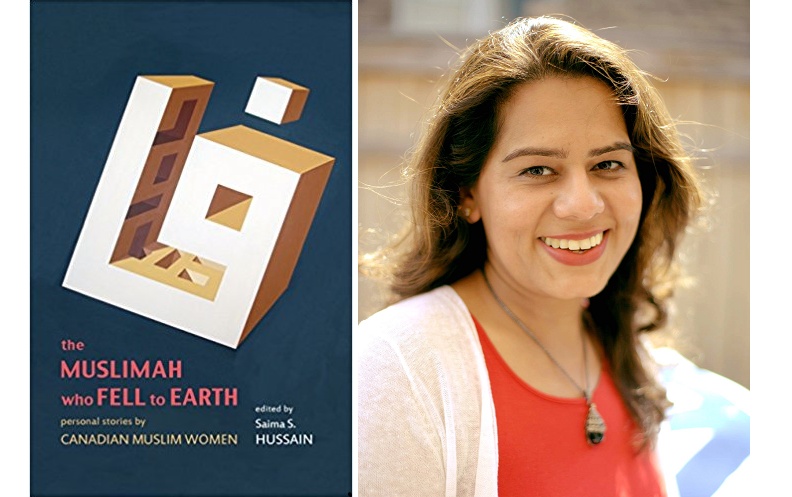Saima Hussain is not the typical Muslim woman one sees on television. She has medium length wavy brown hair that isn’t tucked beneath a hijab, and in one particular interview with a television morning show for Global News Canada, she’s appeared in a soft grey business suit with a longish skirt. So when the need for an essay collection about the diversity of Muslim women was ripe, she was just the person to spearhead the effort.
The Muslimah Who Fell to Earth is an essay anthology showcasing 21 Canadian Muslim women from a variety of backgrounds. None are celebrities and none have particularly scandalous or heartbreaking stories, but what they offer is a glimpse into their ordinary lives, their pasts and their hopes for the future. Hussain felt the urgency of this book after a chance conversation in 2015 with a Catholic friend who confessed that Hussain was the only Muslim person with whom she had ever had a real conversation. Hussain realized that while Muslims live, study and work with their faith counterparts in Canada, their presence didn’t necessarily translate into understandings or personal connections. The gaping silence needed to be filled with conversation.
Hussain began with an idea and not much else, but slowly news of the project spread. She received a call from Haroon Siddique, the “Toronto Star’s” editorial page editor, who introduced her to a publisher, and perhaps more importantly, assured her that the essays was worth compiling. Her doubts fled as the stories began to pour in.
The anthology is stocked with an impressive array of diverse stories and it’s takeaway follows suit: that Muslim women in Canada – and the world – are a diverse demographic. There is no mainstream voice here that dominates the others, no typical portrait that shuts out the rest. That Hussain begins the collection with a controversial topic–the barriers women face in mosques–belies this refusal to ignore some points of view in favor of others. Everyone is heard.
“Where do Muslim women set down their brains when they pass through the women-only entrances to their mosques? Why do they raise funds, volunteer their times, defer to male voices, and accept third-rate spaces? Why do they buy into the lie that within the confines of the mosque, the only intelligence is masculine, and their sole role is to acquiesce?”
Other stories are no less startling for their presence in a book about Muslim women. One narrator is gay, another is mentally ill, a third is severely disabled. There are Sunni women, but there are also women who don’t identify with any sect, as well as Ahmadi and Ismaili women who are often excluded from storytelling forums. There are young women with points-of-view steeped in idealism, and there are older, more tired women who tell stories of compromise and survival. There are stories of spousal abuse juxtaposed with stories of personal achievement, stories set in rural farms alongside ones set in the cosmopolitan centers of the world. Arab women, Indonesian women, Pakistani, African and white women all tell us how they made Canada home.
What the mainstream media is famous for obsessing over, as it relates to Muslim women, is of course the hijab. The Muslimah Who Fell to Earth gives a powerful nod to this reality by including the story of Zunera Ishaq, a woman who gained notoriety after a national case against Prime Minister Harper when he banned her from taking the oath of Canadian citizenship while donning the niqab. If the media insists on showcasing Muslim women under their veils, then it must include strong women who wear those veils with purpose and integrity.
One narrator in the anthology is a poet. She writes secret letters to Rumi, with some poetry of her own:
“What is it about women’s skins – the sweetest landscape –
That send man into vengeful missions to claim a plot on our bodies?
I’m unable to remove the image
Of India’s daughter
Brutally torn apart in 2012
With her intestines
Pulled out. Left to die.
…
Like animals on a hunt
Mouths wide-opened
Sucking on the world’s
Flattery and hypocrisy of
The skin’s canvas
Owned by a woman.
Piece by piece,
Plot by plot,
Landscape sold, packaged
To the highest bidder –
Morsels swallowed.”
For Hussain, sharing these narratives is the only way to stem the tide against negative media representations of Muslims. And if she had showcased only mainstream views, she would be just as guilty of painting her religion with a broad brush as the media. She explains, “So unless the pluralism of Islam was reflected in these stories, the book wasn’t going to be any different from what we see and read in the mainstream media.”
Hussain would like her readers to “take this opportunity to see behind the headlines, outside the soundbites and connect with actual Muslim women.”
Buy The Muslimah Who Fell To Earth on Amazon: https://www.amazon.com/Muslimah-Who-Fell-Earth/dp/1927494826
Saadia Faruqi is the author of Brick Walls: Tales of Hope & Courage from Pakistan, and the editor-in-chief of Blue Minaret, a literary magazine chronicling the Muslim experience. She lives in Houston, TX with her husband and two children.




